Best Beginner Telescope: Celestron Cosmos 90GT WiFi
Every experienced astronomer knows that having the right telescope is invaluable. Whether you are pursuing astronomy for academic and professional reasons or for pure pleasure, the right telescope is the first step towards success. As such, the first piece of advice which is offered to novice astronomers is “find a good telescope”.
Unfortunately, this is easier said and done. If you are an absolute beginner, you may not even know what to look for in a telescope. Luckily for all stargazers, there is one telescope which has been recently described as “the best telescope for beginners”. This telescope has drawn rave reviews from both amateur and experienced astronomers. It is one of the top recommended telescopes for beginners. This is none other than the Celestron Cosmos 90GT WiFi Telescope. My dear wife bought me this beautiful refracting telescope last Christmas, and I have decided to summarise my experience with it in this review.
My Review of Celestron Cosmos 90GT Wifi
I read somewhere that Celestron Cosmos 90GT was designed by Celestron in partnership with the TV show, Cosmos: A Space Odyssey. Built on the show’s fictional “Spaceship of the Imagination”, the telescope is intended to provide newbie astronomers with an opportunity to explore the treasures of the cosmos. It is built to be simple, robust, easy-to-use, and best of all, effective for viewing celestial bodies including the moon, planets, Messier objects and some brightest NGC objects.
The ultimate question is this: does the Celestron Cosmos 90GT live up to its hype? Let’s attempt to answer this question by looking at four major parameters:
Overall Design
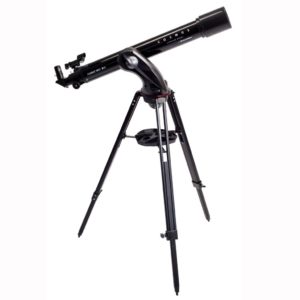 The Celestron Cosmos 90GT WiFi Telescope is a sleek instrument with an elegant, sturdy looking frame. The telescope itself is mounted on a WiFi–controlled rotating base which rests upon a tripod. It is provided with 25mm and 10mm eyepieces. It has a red-dot starfinder on the outside which you can use for sighting the scope, and aiming at distant targets. It is battery operated, and has a battery rack which can take 8 AA batteries.
The Celestron Cosmos 90GT WiFi Telescope is a sleek instrument with an elegant, sturdy looking frame. The telescope itself is mounted on a WiFi–controlled rotating base which rests upon a tripod. It is provided with 25mm and 10mm eyepieces. It has a red-dot starfinder on the outside which you can use for sighting the scope, and aiming at distant targets. It is battery operated, and has a battery rack which can take 8 AA batteries.
The most notable difference from most common telescopes is the absence of a handset. This makes the instrument appear a little peculiar – especially to someone who is familiar with telescopes. However, the conspicuous absence is for a reason: the telescope can be fully controlled using a free mobile app via a WiFi connection. Watching the scope move in response to navigations made via the app is one of the delightful aspects of the Celestron Cosmos 90GT. Even then, there is an aux port on the mount to which a NexStar handset can be connected.
Ease of Use
This 90mm refractor is designed to be as simple, direct and user friendly as possible. And in some respects, it is actually easy-to-use. Setting it up is quite easy, given that all the parts can be put together without the need for any tools.
The telescope is fully controlled via the Cosmos Navigator or SkyPortal apps. These apps are freely available both for iOS and Android platforms. Being able control the telescope via the app makes it extremely easy to use. You can simply point your phone or tablet to the sky, select an object and the telescope will automatically navigate to it. The connection between your device and the telescope is via an inbuilt independent WiFi network. As such, even if you are in a remote location which has no cellular network, you can still control it without a hustle.
The only challenge which this telescope presents (especially to new users) is in aligning it. For the telescope to focus, it first has to be aligned to “three bright objects.” Now, this can be quite challenging, especially to a new user. The challenge arises from the fact that the finderscope also needs to be pointing to the objects you are trying to align to. Unfortunately, this isn’t clearly pointed out in the instructional manual. As such, it can be cause for lots of fumbling (and some doze of frustration). I may have been lucky though as I aligned it on the first time.
The easiest way out of this is to focus the finderscope during the day. Simply find a specific object (e.g. the upper tip of a telephone pole), position the eyepiece until the object is right in the center. Then focus the finderscope dot to point to it. You telescope will now be well tuned, and you won’t have much of a problem getting it aligned.
Accuracy and Focus
The telescope’s app has an inbuilt function which makes it considerably easy to focus on any celestial object. Once the telescope is aligned, you can simply select any object press click “Go-To” and the telescope will automatically move and focus on it. The telescope is fitted with a scope of focal length 910mm and focal ratio f/10.1. Its 90mm aperture can give great views of the moon and other bright deep sky objects.
The telescope also comes with two extra eyepiece lenses which offer greater magnification. It has a 25mm eyepiece which offers 36x magnification. This makes is perfect for viewing planets like mars, Jupiter, and Saturn, as well as nebulae and galaxies. It also has a 10mm eyepiece which offers 91x magnification and is perfect for taking a closer look at the clusters, and zeroing in on specific planets (e.g. closely inspecting Jupiter’s famous rings).
There are two aspects of the Celestron Cosmos 90GT WiFi Telescope which can be quite confusing. First of all, for it to accurately track a target, the tripod legs have to be at the same level. If they are unevenly placed, the tracking system may not accurately zero in on what you want. As such, if you attempt to navigate to a celestial body, but don’t see it, please check the tripod. Secondly, the left and rights in the app are reversed. So, if you are focusing on an object, and want to shift to another at, say 90 degrees, don’t be surprised when the telescope rotates 270 degrees in the opposite direction.
Robustness and Durability
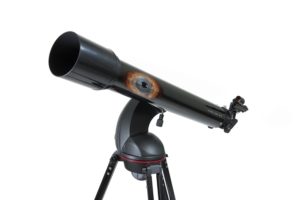 At first appearance, the Celestron Cosmos 90GT WiFi Telescope appears sturdy, strong and robust. It is relatively lightweight, and is easy to set up and set down. Most users have reported having no trouble at all. However, there are some users who have noticed that when you wrap the cord around the battery holder too tightly, some of the wires get pulled out of the chimp connector. When such things happen, simple soldering can quickly put it together. But such incidences demonstrate an inherent fragility.
At first appearance, the Celestron Cosmos 90GT WiFi Telescope appears sturdy, strong and robust. It is relatively lightweight, and is easy to set up and set down. Most users have reported having no trouble at all. However, there are some users who have noticed that when you wrap the cord around the battery holder too tightly, some of the wires get pulled out of the chimp connector. When such things happen, simple soldering can quickly put it together. But such incidences demonstrate an inherent fragility.
The biggest complaint which can be raised about the Celestron Cosmos 90GT WiFi Telescope is that it doesn’t come with a pre-built storage bag. Not that it is particularly difficult to store. However, having a specific bag through which every part can be stored can eliminate the accidental damage which can arise when packing up the various components.
In a nutshell…
The Celestron Cosmos 90GT WiFi Telescope is perhaps the best beginner telescope which is on the market in 2015. It is simple, easy to use, and effective for viewing most celestial objects which any beginner would desire to see. Its use of modern technology for control and navigation gives it a certain cool factor. Its app has a database which actually contains detailed info on close to 100,000 celestial objects. As such, it can be a treasure trove of information for the aspiring astronomer.
The Celestron Cosmos 90GT isn’t without its weaknesses though. It can be quite difficult to master, especially for a first-timer. Its accuracy often depends on all the legs of its tripod being at the same level. On uneven terrain, this can be quite a pain. Also, the lack of a custom-made packing bag means that it is possible to damage some of the components during storage.
However, these weaknesses take nothing away from this telescope’s strong points. The Celestron Cosmos 90GT WiFi Telescope is certainly the best choice for any newbie who wants to make strides into astronomy. It is also a good option if you are buying a first telescope for your kids. Its Amazon price listing of £400 (or £333 with discount) is certainly on the higher side when compared to other beginner telescopes. But then, given the telescope’s numerous positives, it is certainly worth every penny.
Where to buy?
- Amazon UK: Click here to see today’s price
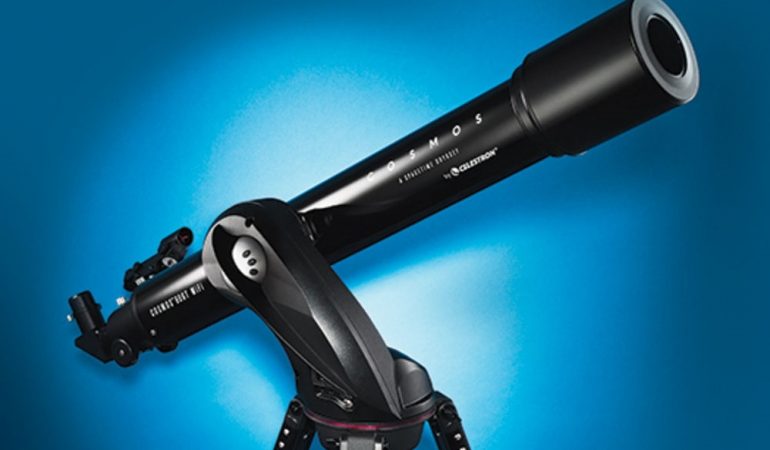
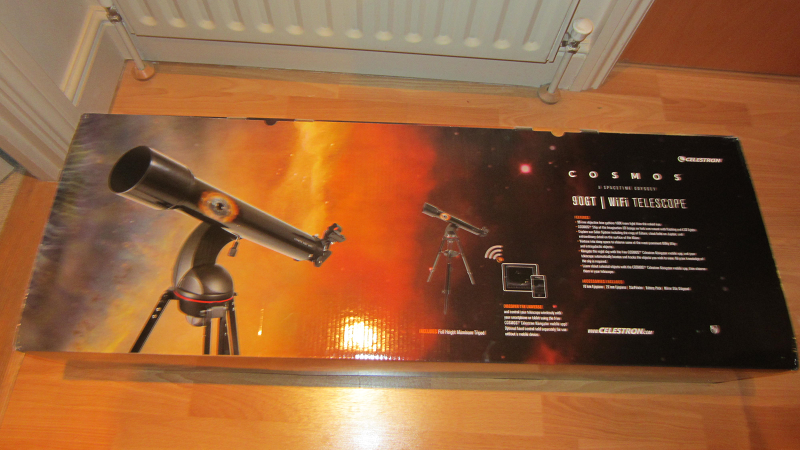
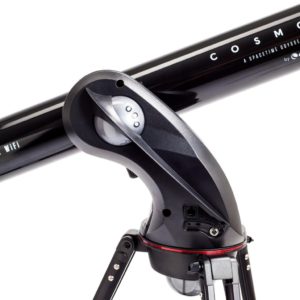
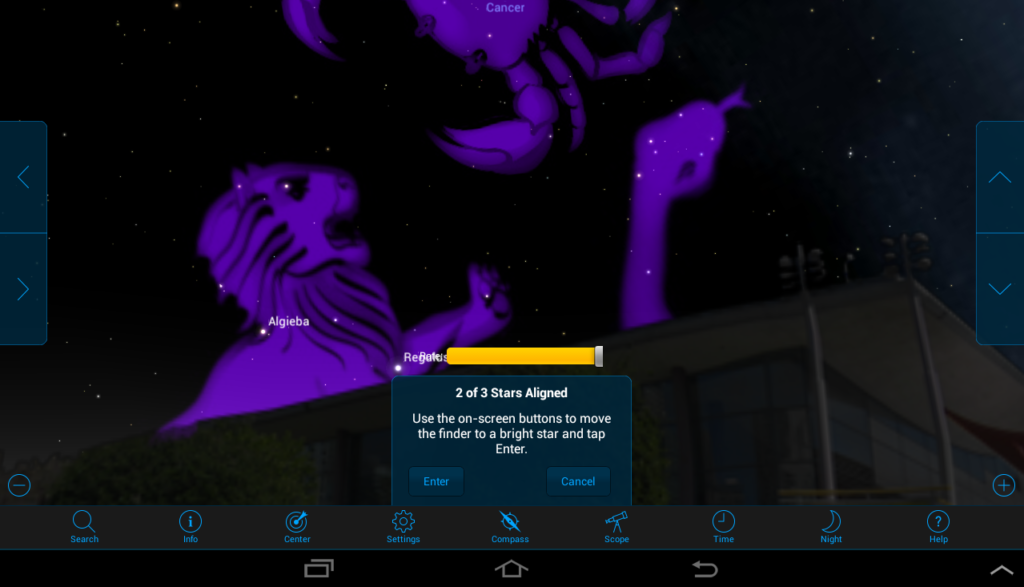

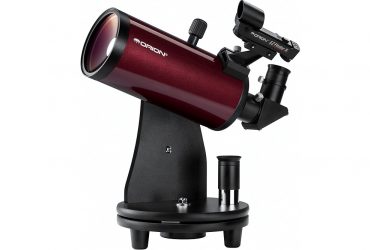

Hi there, great review. I am interested in this telescope but the problem is, i intend to use it for land viewing as well such as bird watching. I would assume this will not be very suitable as the telescope cannot be adjusted manually by hand?
Hi!
Have the same telescope, bought it two days ago. I have not been able to test it yet, to cloudy.
I have a question about the legs of the tripod; do you mean that the surface of the top of the tripod have to be at zero level, and if so, then the legs would be at different levels if the ground surface is slightly sloped?
Strange formulation of the question, I know, but I dont have english as native language.
Tony